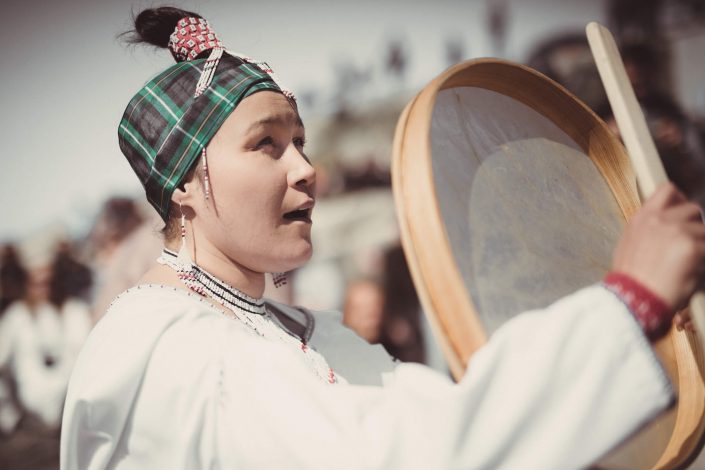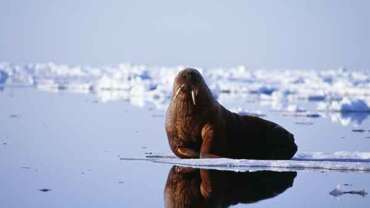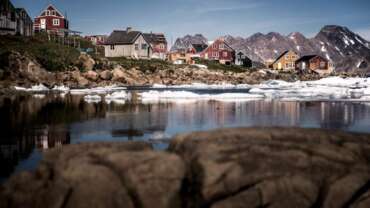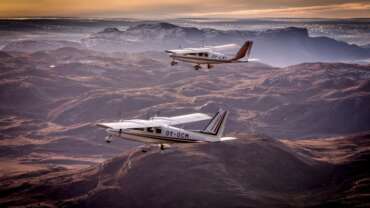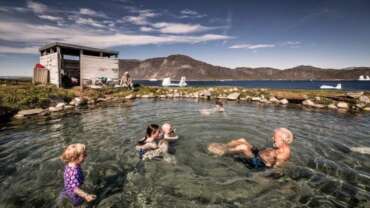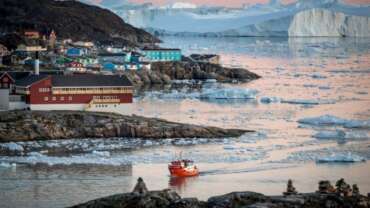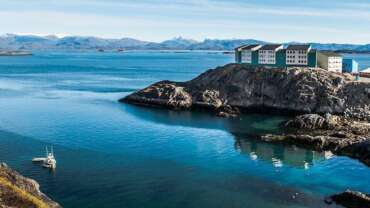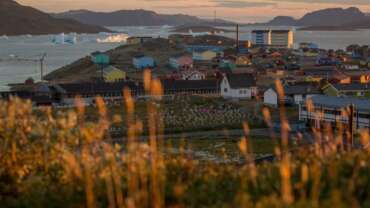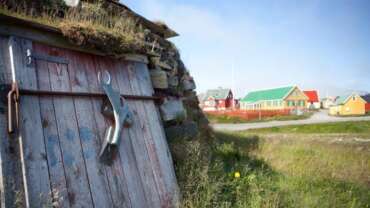Cultural Tourism in Greenland
GREENLANDIC GASTRONOMY
In a country with extensive permafrost and just a tiny bit of arable land, Greenlanders get creative with flavors from both land and sea.
Nature rules all in Greenland, and when it comes to agriculture and Greenland gastronomy it is the everlasting motto. The harsh Arctic climate plays a definitive role, limiting the land wildlife to those mammals that can forage through deep snow and a few adept predators. The Greenland Ice Sheet captures much of the country’s terrain, leaving just the tiniest offering of good soil in South Greenland to run small sheep farms and to grow select fruits and vegetables in small batches.
Out of necessity, the sea, which is naturally overflowing with diverse fish species and many Arctic mammals, came to provide the most Greenlandic food. In fact, the sea became such a gastronomic compass for hunters and fishermen that they often named landforms and settlements after its characteristics. For example, Kapisillit is ‘the place with salmon’ and Ammassalik is ‘the place with capelin’. Thus, Greenland’s waters and hillside combined compose the Greenland cuisine, and what a tasty stock of ingredients it is!
THE ARCTIC INGREDIENTS
Reindeer, Muskox, and South Greenlandic Lamb are Greenland’s succulent equivalents to common livestock. With the exception of a few sheep farms, the animals run wild amongst the Greenland backcountry, and this natural and unstressed life absolutely contributes to the tenderness and high quality of the meat. Small game, such as ptarmigan and snow hare, complete the land repertoire.
The cool Arctic waters offer an impressive selection of cod, trout, Arctic char, redfish, rockfish, and the famed Greenlandic halibut. Not to mention snow crabs as wide as a man’s arms and Greenlandic shrimp and prawns that pack distinct flavor into their miniature size. Even the mountain rivers are so full with fish that, with a quick reflex, you can catch them by hand!
Arctic sea mammals like seals and smaller whales are a delicacy in Greenland cuisine, and the more adventurous gastronomes are always tempted to try them. Taste mattak, a small bite of whale skin and whale blubber, or suaasat, the flavorful national soup made of boiled seal meat.
NEWCOMERS TO GREENLAND RECIPES
Homegrown fruits and vegetables remain more of a side dish than a main course, but a few farmers in South Greenland and some inspired chefs around the country are getting creative. Warming temperatures have allowed for experimentation with potato and strawberry crops and even beekeeping, and already the results have been distributed in small batches along the coast.
Also, a growing focus to incorporate local flora like angelica, crowberry, and blueberry into the gastronomic experience is an innovative step toward synergy of the Greenland food from land and sea.
- Hotel Arctic and Restaurant Mamartut (both in Ilulissat) and Restaurant Roklubben (in Kangerlussuaq) are all known for their weekly buffets featuring Greenland food. Sarfalik in Nuuk feature Greenlandic food in all their recipes.
- In Nuuk and larger towns, you can find Greenland food in Thai, Japanese, American, and French styles.
- Greenlandic food is often smoked, dried, or salted, and served with special sauces.
- In the TV series, A Taste of Greenland, chef Chris Coubrough learns Greenlandic recipes from locals and cooks his way through the five regions of Greenland.
- South Greenland hosts the annual Igasa Food Festival, a multi-day event honoring Greenland gastronomy and the farmers, hunters, fishermen, and chefs behind it.
- There are no regulations about what foods travelers can eat while in Greenland; however, there are regulations about which Greenland food products can be taken upon departure.
- Greenlandic salmon is not exported, so make sure to enjoy it while you’re in Greenland.
TABLE FOR TWO
A buffet or tasting menu is a great introduction to our Greenland recipes, and it ensures you get to taste the whole gamut of local flavors. Trust the chefs as they deliver simple yet beautifully crafted composed plates that make the Greenland food shine.
Of course, you are always welcome to put your own twist on Greenland gastronomy, and it is as simple as purchasing ingredients at the grocery store or fresh market. For a feast for the taste buds and eyes, take your fare to a cozy lookout point and simply enjoy eating the food that came from the very nature you see before you.
INUIT CULTURE IN GREENLAND
The Greenlandic roots are an exciting mix of various immigrating peoples and their ability to adapt to the Arctic challenges on the world’s largest island.
THE LAND OF THE PEOPLE WITHOUT ANY PEOPLE
In the Greenlandic language the name for Greenland is Kalaallit Nunaat. “The Land of the People”. But one day around 2000 years ago, Greenland was suddenly without any people and not a single human being could be found anywhere in the country.
For a period of nearly 2500 years, shifting waves of nomadic peoples, living off what the land and the sea could offer, had called this country home, but now the largest island in the world no longer had a human population.
Imagine a landmass greater than the combined areas of France, Great Britain, Germany, Spain, Italy, Austria, Switzerland and Belgium, just left to plants and animals, and you will get an inkling of how huge the landmass was that greeted the immigrating hunters from communities around the Bering Strait, when they arrived around 700 A.D. coming across at Smith Sound close to the present day town of Qaanaaq, in the most northern part of Greenland.
AN INUIT CULTURE SMELLING OF FORESTS
Today we know, that the group, now referred to as the Dorset Culture, were the ones who came here, to a land void of humans, 1300 years ago.
It seems they may already have been here during an earlier wave of immigration right before the country was depopulated, but in spite of the amount of time they spent in Greenland, the Dorset Culture is shrouded in mystery. Why did they not use kayaks like the groups who came before and after them? How come they did not have dogs and sleds and why are their tools, patterns of habitation and technology so different from other Inuit immigrant groups?
The probable answers have been widely discussed, but the prevailing theory explains them as a group of people arriving here from the Northeast American woodland areas, and that they differ from other groups by “smelling somewhat of forests” as one Danish archeologist put it.
Their origins in this climatic temperate region may explain why they disappeared at the same time with the onslaught of the Little Ice Age in 1300 A.D. which turned Greenland into a colder and more inhospitable region.
.
THE THULE PEOPLE BROUGHT THE SLED DOG WITH THEM TO GREENLAND
The harsher climate and the disappointing summers did not seem to bother the Thule people, a group of highly specialized and adaptable nomads, who quickly spread out all along the ice free coast line around 1300 A.D.
As with other immigrant groups of Inuit peoples, the Thule people had also gone east, this time crossing the Bering Strait into Greenland. According to legends and folklore they had heard about iron and its wonderful properties as a source for tools, and that the iron could be found in meteorites in Northern Greenland.
The Thule people were whale and seal hunters and were most likely the first people to bring dogs into Greenland thus inaugurating the cultural history of dog sledding in Greenland.
They would go on long journeys by dog sled in the areas they were hunting and thus they founded the cultural tradition which in later times has been popularized during the era of expeditions surrounding those by Knud Rasmussen’s travels in Northern Greenland and Arctic Canada, and which today has become an important part of the local culture as well as in adventure tourism.
CULTURAL TRADITIONS LIVE ON IN THE PRESENT
The people of the Thule Culture were using paths and hunting grounds already familiar to other earlier immigrant groups in Greenland, dating back to the very first immigrants 4.500 years ago.
Around the area of Sermermiut by Ilulissat, archeological digs have provided unique insights into the different groups use of the same area for hunting and fishing and from the traces that they have left behind, we know that they travelled along the shores of Greenland as early as 2500 B.C.
Although we have no written accounts from these earlier eras, an abundance of tools and settlements found throughout Greenland has confirmed that the Inuit cultures of the past were characterized by the same adaptability to the prevailing climate and geography as the modern day Greenlandic culture.
We are aware of, that the very first immigrants used vessels resembling kayaks in Greenland and that their clothing were the first glimmerings of a clothing tradition leading right up to today with our colorful national costumes and the winter clothing used by the hunters in Northern Greenland.
Today the kayak is a national symbol in Greenland and the vessel plays an important role as a living part of our cultural history, as well as, in the type of transportation available to adventure expeditions, wanting to explore along our rugged shoreline. Our national costumes are treasured and highly valued and used when we celebrate or commemorate certain events such as national holy days, special family events or when the Queen comes to visit.
MEETING GREENLANDERS
Modern Greenland is a diverse, geographically extensive society with an adventurous population.
A RELAXED AND UNPRETENTIOUS PEOPLE
There is a certain lightheartedness to how we approach life here in Greenland. We don’t take ourselves too seriously. We understand how problems, big and small, need to be solved with whatever is available, and we prefer to understate dramas and events instead of making a big fuss about them.
We are often called hospitable, cheerful, and kind, but even if such universal traits will shape your experience of Greenlanders, we might be better characterized as adaptable, full of wanderlust, and culturally diverse.
CURIOUS AND VERSATILE GREENLANDERS
Scattered on a coastline as long as most of Europe we are fewer people than will fit into your average medium sized soccer field, and our spacious society is so deeply connected with the vagaries of nature that we have nothing but a shrug to give when weather forces us to change plans or wait for days on end.
We are urban in the country’s large towns, we are entrepreneurs, we are fishermen and hunters, and we love the outdoors and life at sea and in the mountains. We flock to every new café serving even just fairly decent coffee, paradoxically we might be the most ice-cream people in the world, we are exceptionally fond of swimming despite a clear lack of ability in the majority of the population, and most of us are familiar with an everyday rhythm of life that one moment sees us working in an office and minutes later we’re standing in a small open boat heading for adventure in the nearest fjord.
THE GRAND IS A PART OF EVERYDAY LIFE
We have a tendency to forget how obvious the drama becomes when you combine the climate and geography of Greenland, and sometimes that makes us slightly immune to the ever-present grandeur which you as a guest will probably notice before anything else.
And we can be almost careless in our mention of significant cultural and climatic events, as if the inherent powers of the land curb the need to use big words.
But conditions here are not inconceivably harsh and we live in neither peat houses nor igloos. Actually, in many ways we’re like any ordinary modern society. And it that sounds a bit bland we only have this to say: It is not! The climate, our cultural history, the flora, fauna, light, sounds, landscapes, language, and not least we as a people create a society that lends a unique edge to life in Greenland.
- The country is 82% ice cap with a small strip of inhabitable land along the shorelines.
- The land mass makes us the world’s 12th largest country, but at the same time we’re one of the sparsely populated places on the planet
- We live in small towns and villages and no roads connect the individual settlements.
- About 90% of the population is of Greenlandic descent, while the remaining 10% are immigrants, mostly from Denmark, but increasingly also from the rest of the world.
- The first language is Greenlandic, Danish is the official second language, and in the street you will even encounter Thai, Norwegian, Icelandic, Filipino, English, and other languages.
MUSEUMS
The museums of Greenland offer a modern voyage of discovery through a history of culture and art.
Greenland has always been a land for travellers, whether they be the very first people to set their sealskin-clad feet on our rocky ground about 4500 years ago, or the European explorers who arrived at the start of the last century.
The huge distances between settlements made long voyages necessary back then, as they do today, and this long historical journey is particularly evident in the narratives at our local museums. Visitors will gain a better understanding of how our ancestors survived in the harsh environment and how they managed to make the best of what the country and the sea had to offer in the way of game animals and materials. You will also learn how the ability to adapt culture and resources was developed.
NATIONAL MUSEUM, ART MUSEUMS & AIRCRAFT MUSEUMS
There are museums in all the larger towns in Greenland and they all tell of our connection to the past, each with a focus on the local environment and cultural conditions. Throughout the year special exhibitions are on display at local museums, including art and photo exhibitions by local and international artists.
Although our history is long, the world of museums in Greenland is fairly new, since all of the museums have been established within the last forty to fifty years. Each part of the country has its own unique history to tell, sometimes expanded by theme museums like the art museums in Nuuk and Ilulissat, or the museum in the South of Greenland which is devoted to the history of communication, all the way from the transfer of messages by kayak to today’s internet.
The airports in Narsarsuaq and Kangerlussuaq, built by the Americans, each have their own museum describing the history of aviation and the importance of air transportation during the Second World War.
NORSE HISTORY AND IMMIGRATION CULTURES
Often the museums themselves are part of the narrative they tell, as they are usually located in old buildings near the harbour, in buildings from the colonial era, or in buildings tied to airports.
At the same time, the museums are centers of knowledge of local historical events – the local museum can show you the way to ruins from the era of the Norsemen, or sites where tents and huts were erected by Inuit immigrants.
At the museums, the stories of the different cultures coming to Greenland meet, and by viewing artifacts and reading about local history, you will learn how waves of nomadic peoples, Norsemen, Christian Europeans, and with time, people from all over the world, have shaped the history of Greenland, and are shaping our modern society today.
PHOTO TOURS IN GREENLAND
Photo tours in Greenland add new dimensions to landscapes and culture, wildlife and natural phenomena, by exploring the destination through a lens.
Narrative Art
Images are about the art of telling stories to create emotions, and about bringing out the narrative in dramatic seasonal changes, people and culture, the northern lights, the living ice cap, and whale migrations.
Photo tours in Greenland are a unique way to explore the country, and when working with a camera you apply a distinct vision to the destination. Traveling photographers tend to become creative explorers for whom image making becomes an expressive passion.
Photographers tend to be both lone wolves and gregarious at the same time. They like to work on their own but often travel together in small groups, sharing experiences and learning new photographic techniques along the way, while looking for inspiration from tour leaders and peers.
THE LIGHT AND THE LAND
We know from photographers we meet in Greenland that the majority are looking for landscapes and wildlife; they like to explore the subtle colors of the destination and move from tiny details in rocks and ice to sweeping panoramic stories and back.
Light is a key tool for any photographer and it can be harnessed to create drama, contrasts, and to bring out emotions in the story of the image, which is why photo tours are always a combination of timing and location.
In Greenland, locations define our rough, mountainous and contrasting land, which is sparsely populated in small local communities, dominated by the enormous ice sheet, and shaped by the Arctic climate.
Nightscapes
The night holds a special place in Greenland, both because the bright summer nights provide golden hour lighting conditions for hours, and because in late summer and throughout the winter season the dry climate and lack of light pollution bring out the northern lights and stars on the night skies.
The northern lights, or aurora borealis, are the obvious attraction of the night, especially at latitudes around and just south of the Arctic Circle, such as Tasiilaq, Sisimiut, Nuuk, and Maniitsoq, where the northern lights are particularly bright from September until April.
The real gem, however, is Kangerlussuaq on the west coast, which delivers clear skies more than 300 nights a year, and where you can go on northern lights trips with World of Greenland Arctic Circle.
The darkness also brings out other adventures, both nature based and photographic, adding perspective and depth to the experience, and for many photographers night photography is a way to combine exciting challenges with an almost therapeutic activity.
A diversity of locations
East Greenland is an established photo tour destination, and in the backcountry around Tasiilaq, the combination of alpine landscapes, ice fjords, the neighboring ice sheet, and small local communities makes this a popular place for adventurous photographers. They tend to use the logistical expertise of Travellodge Greenland and Red House Tasiilaq for small group travel, and the primary season is in August and September when the harsh summer light fades and becomes more manageable.
In North Greenland, in Disko Bay around the main town Ilulissat, and at the UNESCO world heritage site by the ice fjord Kangia, photographers take advantage of a concentration of locations which give access to icebergs, whales, local hunting and fishing communities and the volcanic rocks on Disko Island, all neatly tied together by a network of boat routes between towns and settlements.
South Greenland is a farming landscape set on a backdrop of sharp peaks, ice fjords, flower fields, and colorful coastal towns in a region known for its well preserved norse settlement ruins and Atlantic feel.
Other locations on the west coast of Greenland offer semi-urban cultural experiences and fjordscapes, while the far north offers Arctic desert, extreme seasonal differences, and unique lighting conditions for explorers of light who like expedition-style adventures and new challenges.
SOUVENIR SHOPPING
Keep your memories close to your heart as reindeer horn, soapstone and muskox wool turn into souvenirs like symbolic statues, beautiful jewelry and clothing for you to carry home.
A GREENLANDIC IDENTITY
It is said that one can recognize the essence of a people through their artwork because they instinctively depict what is central to their lives, and in Greenland the souvenirs tell the story of the country as a pioneering nation.
Ritualistic figures called tupilaks, intricate depictions of hunting and fishing, tools like the woman’s knife called an ulo, and carvings of polar bears, whales, and seals are all evidence of a people with close connection to the natural environment, who have thrived in Greenland by adapting their lives to nature’s way.
Greenlandic identity is shown not only through the images that souvenirs depict but also through their materials. As sustainable hunters, we only take the animals needed and we use every possible part. The bones and warm fur of Arctic mammals turn into jewelry and clothing, so souvenir shops are stocked with pieces made of reindeer and muskox horn, sealskin, muskox wool, and even polished whale baleen.
Greenlandic identity runs high as souvenirs depict Greenlandic images on the canvas of Greenlandic materials, and the fact that locals themselves proudly wear the same items that travelers buy as souvenirs bears testament to their authenticity.
BREAKING THE MOLD
Authentic comes in more forms than just animal bones. An increasing number of our artists are breaking the mold and putting a creative spin on Greenlandic souvenirs by using plastic, ceramic, or metal materials and by designing fur clothing with the international catwalk in mind. This adaptation of classic elements shows respect for the history that shaped Greenlandic society today while demonstrating that Greenlanders are solid members of the global community.
A rare, but incredibly beautiful, souvenir to find is jewelry made of gold from South Greenland. The production mine is now closed, making the supply of items that resulted from the area quite exclusive. Just imagine bringing your dearest to Greenland and leaving with one of the most unique souvenirs in the world – a set of wedding rings forged by hand out of Greenlandic gold!
- There are rules regarding which souvenirs made from animal products can be exported from Greenland, and some souvenirs require a CITES permit at no cost to you. For more information, consult an updated CITES page.
- Where to buy souvenirs: Souvenir shops, handicraft workshops, Kittat Économusée sewing workshop, hotels, tourist offices, and Sarfaq Ittuk, the Arctic Umiaq Line coastal ferry.
- What souvenirs to buy: Artwork and jewelry from local artists; tupilaks; sealskin clothing from Great Greenland; ornaments; statues and figurines carved from soapstone, reindeer horn, muskox horn, whale baleen, or walrus tooth; accessories knit from muskox wool.
KNOW YOUR REINDEER FROM YOUR NARWHAL
With so many souvenir shops to browse and even more souvenirs to mull over, it is easy to want a bit of everything. But there is one thing that helps narrow the difficult decision: The CITES export regulations.
Part of protecting the beautiful Arctic wildlife is keeping some animals sacred to Greenland. Souvenir shops will happily advise you on which items must stay in Greenland and which souvenirs can be yours to cherish forever.



